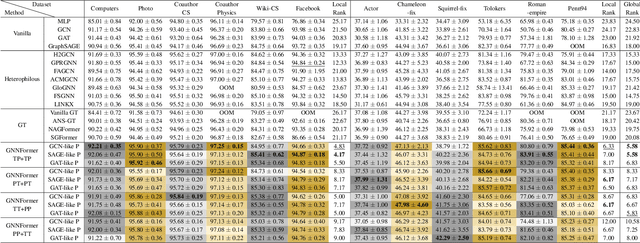Yu Shanqing
Rethinking Graph Transformer Architecture Design for Node Classification
Oct 15, 2024



Abstract:Graph Transformer (GT), as a special type of Graph Neural Networks (GNNs), utilizes multi-head attention to facilitate high-order message passing. However, this also imposes several limitations in node classification applications: 1) nodes are susceptible to global noise; 2) self-attention computation cannot scale well to large graphs. In this work, we conduct extensive observational experiments to explore the adaptability of the GT architecture in node classification tasks and draw several conclusions: the current multi-head self-attention module in GT can be completely replaceable, while the feed-forward neural network module proves to be valuable. Based on this, we decouple the propagation (P) and transformation (T) of GNNs and explore a powerful GT architecture, named GNNFormer, which is based on the P/T combination message passing and adapted for node classification in both homophilous and heterophilous scenarios. Extensive experiments on 12 benchmark datasets demonstrate that our proposed GT architecture can effectively adapt to node classification tasks without being affected by global noise and computational efficiency limitations.
Cross Cryptocurrency Relationship Mining for Bitcoin Price Prediction
Apr 28, 2022



Abstract:Blockchain finance has become a part of the world financial system, most typically manifested in the attention to the price of Bitcoin. However, a great deal of work is still limited to using technical indicators to capture Bitcoin price fluctuation, with little consideration of historical relationships and interactions between related cryptocurrencies. In this work, we propose a generic Cross-Cryptocurrency Relationship Mining module, named C2RM, which can effectively capture the synchronous and asynchronous impact factors between Bitcoin and related Altcoins. Specifically, we utilize the Dynamic Time Warping algorithm to extract the lead-lag relationship, yielding Lead-lag Variance Kernel, which will be used for aggregating the information of Altcoins to form relational impact factors. Comprehensive experimental results demonstrate that our C2RM can help existing price prediction methods achieve significant performance improvement, suggesting the effectiveness of Cross-Cryptocurrency interactions on benefitting Bitcoin price prediction.
 Add to Chrome
Add to Chrome Add to Firefox
Add to Firefox Add to Edge
Add to Edge